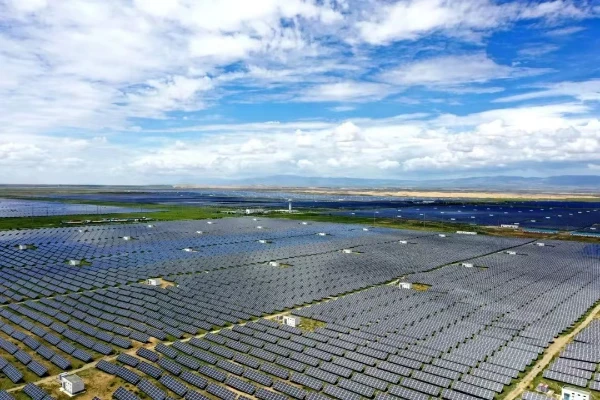A single-axis solar tracker is an advanced photovoltaic (PV) system that maximizes energy output by orienting solar panels toward the sun throughout the day. The slewing drive is a crucial component in these systems, responsible for enabling smooth and precise rotational movement. In this blog post, as a high precision slew drive for solar tracker system manufacturer, YOJU will share the components and working principle of single axis solar tracker slewing drive for sale.
What is Single Axis Solar Tracker Slewing Drive?
A slewing drive is a compact and self-contained system designed to transmit torque and rotational motion in a single-axis solar tracker. It integrates a gear mechanism, typically a worm gear drive, with an electric motor to enable controlled movement. The slewing drive ensures optimal tracking performance, with high efficiency and load-bearing capabilities.
Components of Single Axis Solar Tracker Slewing Drive
A single-axis solar tracker slewing drive consists of several key components:
1. Worm Gear Mechanism: This is the core of the drive, consisting of a worm and a worm wheel. The worm gear provides high gear reduction ratios, ensuring slow and controlled movement.
2. Housing: The outer casing that encloses the internal components, protecting them from environmental factors such as dust, water, and corrosion.
3. Electric Motor: The motor provides the necessary torque to drive the worm gear. It can be either AC or DC, depending on system requirements.
4. Rotary Bearing: This allows smooth and low-friction rotation, supporting the structure while reducing mechanical wear.
5. Braking System: A self-locking feature in the worm gear mechanism prevents unwanted back-driving, ensuring stability under wind loads.
6. Sealing and Lubrication: Proper sealing mechanisms and lubricants are used to enhance performance and durability by reducing friction and preventing contamination.

Single Axis Solar Tracker Slewing Drive Working Principle
The slewing drive in a single-axis solar tracker operates based on precise control signals and mechanical actuation. Below is a step-by-step breakdown of its working principle:
1. Sun Position Detection
A solar tracker controller uses a light sensor (e.g., a pyranometer or photodiode array) or an astronomical algorithm to determine the sun' s position at any given time. This data is sent to the control unit, which processes the optimal angle for solar panel orientation.
2. Motor Actuation
Based on the processed data, the control unit sends a signal to the electric motor to initiate movement. The motor provides rotational force to the worm shaft, which engages with the worm wheel.
3. Worm Gear Transmission
The worm gear mechanism translates the rotational movement of the motor into a slow, controlled motion that moves the solar panel array along a single axis. Due to the high gear reduction ratio, small motor input results in precise, smooth, and powerful rotation of the solar panels.
4. Torque Transfer and Load Bearing
The rotary bearing within the slewing drive supports the load of the solar panel system, ensuring smooth movement and reducing mechanical stress. The bearing design allows it to handle axial, radial, and moment loads efficiently.
5. Braking and Holding Position
Once the desired panel orientation is achieved, the self-locking nature of the worm gear prevents any unintended movement caused by wind or vibrations. This ensures stability without additional braking mechanisms.
6. Real-time Adjustments
Throughout the day, the control unit continuously monitors sun movement and adjusts the position of the solar tracker accordingly. The slewing drive facilitates these incremental adjustments with high accuracy.
Advantages of Slewing Drive in Solar Tracker System
1. High Efficiency and Precision
The use of worm gear transmission ensures precise angular movement with minimal backlash, improving tracking accuracy and maximizing solar energy capture.
2. Self-locking Mechanism
The inherent self-locking capability of the worm gear eliminates the need for additional brakes, enhancing stability and safety against high wind loads.
3. Compact and Durable Design
Slewing drives are compact, enclosed systems that offer excellent resistance to environmental factors such as moisture, dust, and extreme temperatures, ensuring long service life.
4. Reduced Maintenance
With fewer moving parts and a well-sealed structure, slewing drives require minimal maintenance compared to other tracking mechanisms, lowering operational costs.
5. Scalability
Slewing drives can be designed for small residential solar trackers or large utility-scale solar farms, offering versatile application possibilities.
Conclusion
The slewing drive is an essential component in single-axis solar trackers, enabling precise and efficient movement of solar panels for maximum energy capture. Its robust design, self-locking feature, and durability make it an ideal choice for long-term solar tracking applications. While challenges exist, advancements in material engineering and control systems continue to enhance the performance and reliability of slewing drive mechanisms in solar energy applications.
By understanding the working principles of a single-axis solar tracker slewing drive, engineers and solar industry professionals can optimize solar tracking solutions for enhanced efficiency and sustainability.
www.enyoju.com
YOJU

+ There are no comments
Add yours